Introduction
Vulvodynia is a chronic pain condition characterized by persistent or recurrent pain in the vulvar region, lasting for at least three months, without an identifiable cause. This condition can significantly impact a person’s quality of life, affecting physical activities, sexual health, and emotional well-being. Despite its prevalence, vulvodynia remains underdiagnosed and misunderstood due to its complex nature and the stigma surrounding discussions about genital pain.
Etiology
The exact etiology of vulvodynia remains elusive, with researchers identifying it as a multifactorial condition. This means that multiple interrelated factors contribute to its development. Understanding the underlying causes is crucial for appropriate treatment and management.
- Neurological Factors
Abnormal nerve signaling in the vulvar region is a significant component. Studies suggest that vulvodynia may involve hyperactivity of nerve fibers, leading to heightened sensitivity and pain in response to stimuli that are typically non-painful. - Inflammatory Responses
Some cases of vulvodynia may result from an exaggerated inflammatory response to minor injuries or infections in the vulvar tissue. Persistent inflammation can sensitize the nerves, leading to chronic pain. - Muscular Dysfunction
Dysfunction or overactivity of the pelvic floor muscles can contribute to vulvodynia. These muscles may become tense or spasm, exacerbating the pain. - Genetic Predisposition
Certain genetic factors may make individuals more susceptible to conditions involving chronic pain and inflammation, including vulvodynia. - Psychological Factors
Although vulvodynia is not a psychological disorder, stress, anxiety, and depression can exacerbate the condition. These factors may increase the perception of pain or contribute to muscular tension in the pelvic region.
Causes
While the etiology highlights the underlying mechanisms, specific causes or triggers can initiate or worsen vulvodynia:
Trauma or Injury
Childbirth, sexual intercourse, or medical procedures may cause trauma to the vulvar area, triggering pain responses.
Infections
Recurrent yeast or bacterial infections can lead to nerve sensitization in the vulvar region, even after the infection has resolved.
Allergic Reactions or Irritants
Exposure to allergens or irritants, such as perfumed products, tight clothing, or harsh detergents, can irritate the vulvar tissue, contributing to pain.
Hormonal Changes
Hormonal fluctuations during menopause, oral contraceptive use, or postpartum periods can thin vulvar tissues, potentially leading to discomfort and pain.
Sexual Trauma or Abuse
In some cases, a history of sexual trauma or abuse may contribute to the development or persistence of vulvodynia.
Symptoms
The symptoms of vulvodynia can vary widely among individuals, but the most common symptom is vulvar pain, which may be:
Burning or Stinging: A persistent burning sensation is a hallmark of vulvodynia.
Irritation or Rawness: The vulvar area may feel constantly irritated or raw.
Throbbing or Aching: Some individuals report throbbing pain or a dull ache in the vulvar region.
Localized or Generalized Pain: Pain may occur in a specific area (localized vulvodynia) or throughout the vulvar region (generalized vulvodynia).
Pain Triggered by Activities: Symptoms are often exacerbated by activities such as sitting, cycling, wearing tight clothing, or sexual intercourse (dyspareunia).
The pain may be constant or intermittent, with intensity ranging from mild discomfort to debilitating agony.
Treatment and Management
Treating vulvodynia requires a multidisciplinary approach, as no single treatment works for everyone. The goal is to alleviate pain, improve function, and enhance quality of life.
Medical Treatments
Medications
Topical Anesthetics: Lidocaine ointments can numb the vulvar area, providing temporary relief.
Antidepressants: Tricyclic antidepressants, like amitriptyline, help manage chronic pain by modifying nerve signals.
Anticonvulsants: Gabapentin and pregabalin are sometimes prescribed for nerve pain.
Hormone Creams: In cases related to hormonal imbalances, estrogen or testosterone creams may be beneficial.
Physical Therapy
Pelvic floor physical therapy focuses on relaxing and strengthening the muscles in the pelvic region. Techniques include biofeedback, stretching exercises, and manual therapy.
Trigger Point Injections
For localized vulvodynia, corticosteroid or anesthetic injections directly into the painful area can provide relief.
Surgery
In rare cases where other treatments fail, vestibulectomy (removal of painful tissue) may be considered.
Lifestyle Modifications
Avoid Irritants
Switch to hypoallergenic and fragrance-free products, and wear loose-fitting cotton underwear.
Dietary Changes
An anti-inflammatory diet rich in omega-3 fatty acids, antioxidants, and low in processed foods may help reduce inflammation.
Stress Management
Incorporate stress-reducing practices such as yoga, meditation, or counseling to address psychological factors contributing to pain.
Psychological and Behavioral Therapy
Cognitive Behavioral Therapy (CBT)
CBT helps patients reframe negative thoughts about pain, improving coping mechanisms and reducing emotional distress.
Sex Therapy
For those experiencing pain during intercourse, sex therapy can provide strategies to manage intimacy issues and improve communication with partners.
Complementary Therapies
Acupuncture
This traditional Chinese medicine practice may help reduce pain perception and promote relaxation.
Biofeedback
By using devices to monitor muscle activity, individuals can learn to control and relax pelvic muscles.
Massage Therapy
Manual therapy can alleviate muscle tension in the pelvic region.
Conclusion
Vulvodynia is a complex and multifaceted condition that demands personalized care. While its causes and mechanisms are not fully understood, advancements in research and treatment options provide hope for those affected. Early diagnosis, combined with a multidisciplinary approach involving medical, physical, and psychological interventions, can significantly improve outcomes. It is essential to foster awareness and eliminate stigma to ensure that individuals with vulvodynia receive the care and support they need.
Contributor – Dr. Prabhakar Sharma




